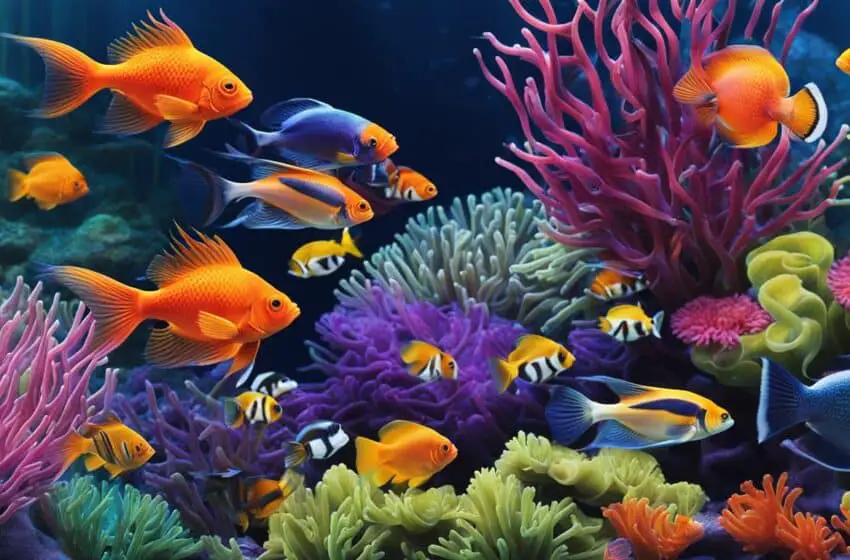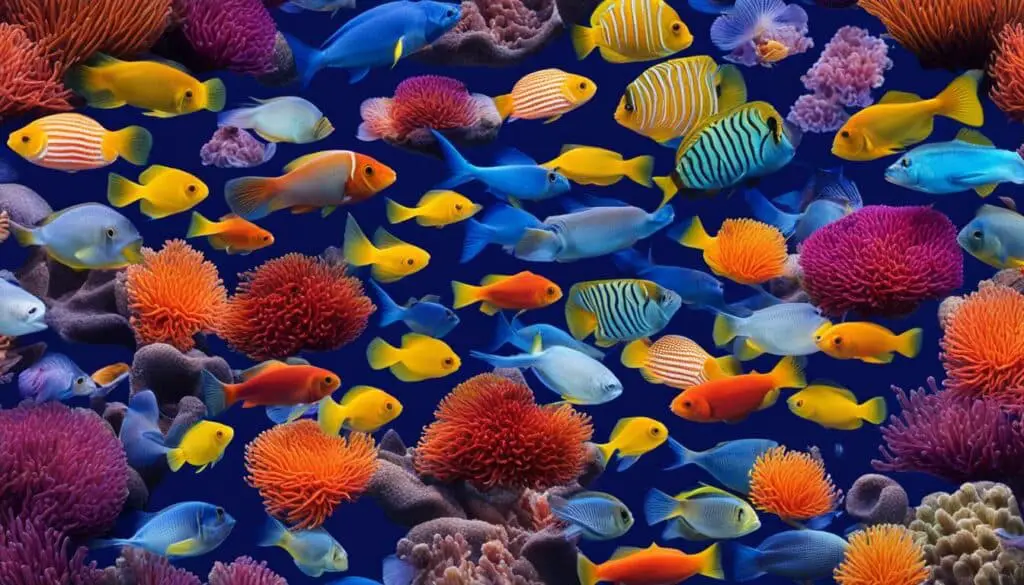Mastering Anemone Care: A Guide For Aquarium Enthusiasts

Sea Anemones In Aquarium: Sea anemones, also known as anemones, are beautiful yet challenging creatures to keep in an aquarium. They have specific needs and can influence the overall ecosystem of your tank. Sea anemones belong to the class Anthozoa and have a columnar trunk topped by a ring of tentacles and a central mouth. They are primarily predatory and use their stinging cells to paralyze their prey. While most anemones are not a danger to humans, it is important to handle them with gloves due to the toxins they release. Some species of anemones have a symbiotic relationship with single-celled organisms that live within their cells and supply them with oxygen and glucose.
Anemones can coexist with certain species of fish and invertebrates, such as clownfish, cardinalfish, gobies, shrimp, and crabs. However, it is crucial to carefully observe their interactions and ensure that their tank mates are not aggressive or harmful. It is also important to note that anemones should not be introduced to tanks that already contain corals and other sessile invertebrates, as they may engage in chemical warfare against each other.
To maintain proper tank conditions for anemones, stable water parameters, high water quality, and proper lighting are essential. Anemones should be placed in an area with plenty of room and appropriate substrate. Supplemental feeding may be necessary, but it is important to avoid overfeeding to prevent water pollution. When purchasing anemones, it is crucial to choose healthy specimens with intact bases and vibrant colors. Reputable sellers that engage in sustainable harvesting methods should be preferred.
Key Takeaways:
- Anemones have specific needs and can influence the ecosystem of your tank.
- They are primarily predatory and use stinging cells to paralyze their prey.
- Some species of anemones have a symbiotic relationship with single-celled organisms.
- Compatible tank mates for anemones include clownfish, cardinalfish, gobies, shrimp, and crabs.
- Anemones should not be introduced to tanks with corals and other sessile invertebrates.
Anemone Species Recommendations for Your Aquarium

When it comes to selecting anemone species for your aquarium, it is important to consider their specific requirements and compatibility with other tank mates. Choosing the right anemones will not only ensure their well-being but also contribute to creating a harmonious and visually stunning underwater environment.
Heteractis crispa
Heteractis crispa, also known as the sea anemones in aquarium, is a popular choice among aquarists. With its vibrant colors and long flowing tentacles, it adds a beautiful aesthetic to any tank. This species prefers strong lighting and pristine water conditions. Suitable tank mates for Heteractis crispa include clownfish, damselfish, and small peaceful reef fish.
Heteractis malu
The Heteractis malu, commonly known as the Maroon anemone or the Carpet anemone, is another visually striking species. It is characterized by its intricate patterns and delicate appearance. Heteractis malu requires moderate to high lighting and stable water parameters. It is best suited to tanks with larger fish species such as angelfish and larger clownfish varieties.
Condylactis gigantea
Condylactis gigantea, also called the Haitian anemone, is a hardy species that can adapt well to various tank conditions. It has short, stubby tentacles and comes in a range of colors, including green, purple, and brown. Condylactis gigantea can coexist with peaceful fish species like gobies, cardinalfish, and wrasses.
Entacmaea quadricolor
The Entacmaea quadricolor, commonly known as the Bubble tip anemone, is a favorite among reef hobbyists. It gets its name from the bubble-like tips that form on its tentacles. This species thrives under moderate lighting and stable tank parameters. Suitable tank mates for Entacmaea quadricolor include clownfish, gobies, and small reef-safe wrasses.
Bartholomea annulata
Bartholomea annulata, also known as the Corkscrew anemone, is a unique species that has a spiral pattern on its column. It prefers low to moderate lighting conditions and requires pristine water quality. Bartholomea annulata can be housed with non-aggressive fish species such as cardinals, gobies, and blennies.
Cerianthys Tube Anemones
Cerianthys Tube Anemones are a less common but fascinating choice for aquarium enthusiasts. They reside in tubes they create from their own secretions and have a unique appearance compared to other anemone species. Cerianthys Tube Anemones require moderate lighting and stable tank conditions. They can coexist with peaceful reef fish such as chromis, gobies, and dartfish.
It is important to note that while these anemone species are generally considered suitable tank mates, each aquarium is unique. Careful observation and research should be conducted before introducing any species to ensure compatibility and a thriving ecosystem for your anemones and other inhabitants.

| Anemone Species | Lighting Requirements | Recommended Tank Mates |
|---|---|---|
| Heteractis crispa | Strong lighting | Clownfish, damselfish, small peaceful reef fish |
| Heteractis malu | Moderate to high lighting | Angelfish, larger clownfish varieties |
| Condylactis gigantea | Varies, adaptable | Gobies, cardinalfish, wrasses |
| Entacmaea quadricolor | Moderate lighting | Clownfish, gobies, small reef-safe wrasses |
| Bartholomea annulata | Low to moderate lighting | Cardinals, gobies, blennies |
| Cerianthys Tube Anemones | Moderate lighting | Chromis, gobies, dartfish |
Important Considerations for Keeping Anemones in Your Tank
When it comes to keeping sea anemones in aquarium, there are several important considerations you need to keep in mind. Creating proper tank conditions for anemones is crucial to their well-being and overall survival.
First and foremost, lighting plays a vital role in the health of anemones. They require appropriate lighting conditions to thrive. Providing the right intensity and spectrum of light is essential for their photosynthetic symbiotic partners and ensures the anemones can generate the necessary energy for their survival.
In addition to lighting, maintaining stable tank parameters is crucial for the well-being of anemones. This includes monitoring and controlling factors such as temperature, pH levels, salinity, and water flow. Anemones are sensitive creatures, and fluctuations in these parameters can cause stress and even lead to their demise.
Feeding anemones is another important aspect of their care. While they obtain some of their nutrition through the photosynthetic relationship with their symbiotic partners, supplemental feeding may be necessary. However, it’s crucial not to overfeed them, as excess nutrients can result in water pollution and harm the overall tank ecosystem.
Lastly, when it comes to mixing anemones in your tank, it’s essential to exercise caution. Not all anemone species are compatible with each other. Some species can exhibit aggressive behaviors towards one another, leading to conflicts and potential harm. It’s best to research and choose anemones that are known to coexist peacefully, ensuring a harmonious tank environment.
FAQ
What are some suitable tank mates for anemones?
Anemones can coexist with certain species of fish and invertebrates, such as clownfish, cardinalfish, gobies, shrimp, and crabs. However, it is important to observe their interactions and ensure that their tank mates are not aggressive or harmful.
Can anemones be kept with corals and other sessile invertebrates?
Anemones should not be introduced to tanks that already contain corals and other sessile invertebrates, as they may engage in chemical warfare against each other.
What are the essential tank conditions for anemones?
To maintain proper tank conditions for anemones, stable water parameters, high water quality, and proper lighting are essential. Anemones should be placed in an area with plenty of room and appropriate substrate.
Do anemones require supplemental feeding?
Anemones may require supplemental feeding, but it is important to avoid overfeeding to prevent water pollution.
How do I choose healthy anemone specimens?
When purchasing anemones, choose healthy specimens with intact bases and vibrant colors. It is also advisable to buy from reputable sellers that engage in sustainable harvesting methods.
What are some recommended anemone species for aquariums?
Some recommended anemones for aquariums include Heteractis crispa, Heteractis malu, Condylactis gigantea, Entacmaea quadricolor, Bartholomea annulata, and Cerianthys Tube Anemones.
What are the important considerations for keeping anemones in a tank?
Important considerations for keeping anemones in a tank include proper tank conditions, such as stable water parameters and appropriate lighting, as well as feeding and avoiding mixing incompatible anemones.



